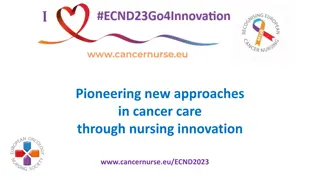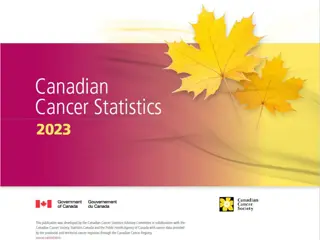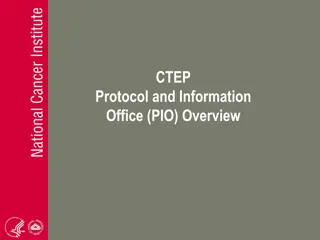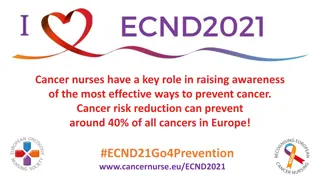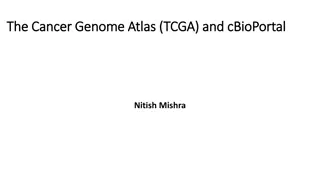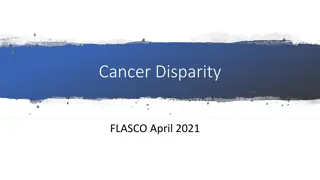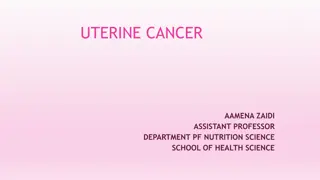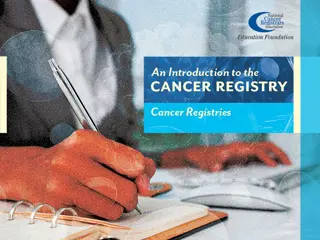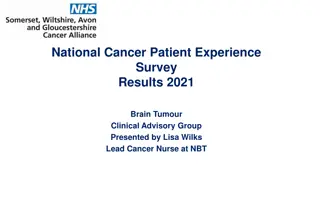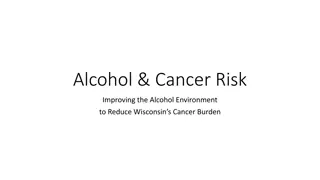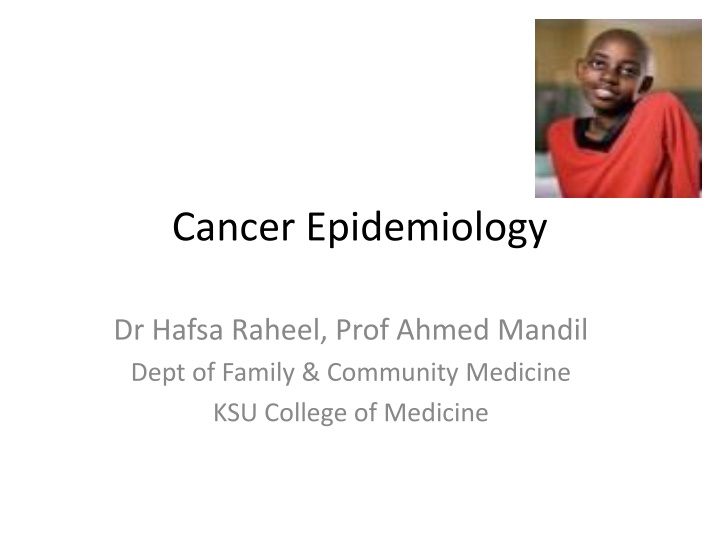
Insights on Cancer Epidemiology and Historical Perspectives
Explore the field of cancer epidemiology, learn about the global impact of cancer, prevalent types, leading causes of cancer deaths, and historical insights dating back to ancient civilizations. Discover the biologic basis for cancer control and grasp the importance of research for future directions in cancer studies.
Download Presentation

Please find below an Image/Link to download the presentation.
The content on the website is provided AS IS for your information and personal use only. It may not be sold, licensed, or shared on other websites without obtaining consent from the author. If you encounter any issues during the download, it is possible that the publisher has removed the file from their server.
You are allowed to download the files provided on this website for personal or commercial use, subject to the condition that they are used lawfully. All files are the property of their respective owners.
The content on the website is provided AS IS for your information and personal use only. It may not be sold, licensed, or shared on other websites without obtaining consent from the author.
E N D
Presentation Transcript
Cancer Epidemiology Dr Hafsa Raheel, Prof Ahmed Mandil Dept of Family & Community Medicine KSU College of Medicine
Learning Objectives Students should be able to: Appreciate the historical perspective of cancer control Explain the Global impact of cancer Identify the most prevalent cancers world wide Identify the leading causes of cancer deaths Understand the cancer control continuum and explain its implication to public health Explain important factors and trends affecting cancer control and directions for future research Cancer Epidemiology 19 March 2025 2
What is cancer? Definition: Cancer is a generic term for a group of more than 100 diseases that can affect any part of the body. Other terms used are malignant tumors and neoplasm ..WHO Cancer Epidemiology 19 March 2025 3
Biologic Basis for Cancer Control Progression Initiation Promotion Normal cell Initiated cell Pre-cancerous cell CANCER Cancer Epidemiology 19 March 2025 4
CANCER HISTORY Human cancer is probably as old as the human race. It is obvious that cancer did not suddenly start appearing after modernization or industrial revolution. Cancer Epidemiology 19 March 2025 5
ANCIENT EGYPT (3000 BC-1500 BC) 1 The oldest known description of human cancer is found in 7 Egyptian papyri written between 3000-1500 BC. Two of them, known as the "Edwin Smith" and "George Ebers" papyri, contain details of conditions that are consistent with modern descriptions of cancer. Cancer Epidemiology 19 March 2025 6
HIPPOCRATES (460-370 B.C) 1 He is the first person to clearly recognize difference between benign and malignant tumors His writings include description of cancers involving various body sites Cancer Epidemiology 19 March 2025 7
HIPPOCRATES (460-370 B.C) 2 Hippocrates noticed that blood vessels around a malignant tumor looked like the claws of crab. He named the disease karkinos (the Greek name for crab) to describe tumors. In English this term translates to carcinos or carcinoma. Cancer Epidemiology 19 March 2025 8
Global Burden of Disease Total of 58 million deaths worldwide in 2005, cancer accounts for 7.6 million (or 13%) of all deaths Main types: lung (1.3 million deaths/year); Stomach (almost 1 million deaths/year); Liver (662,000 deaths/year); Colon (655,000 deaths/year) and Breast (502,000 deaths/year). Cancer Epidemiology 19 March 2025 9
Cancer incidence for the regions of the world, 2002 estimates Cancer Epidemiology 19 March 2025 10
Cancer Epidemiology 19 March 2025 11
Estimated Cancer Deaths Men 295,280 Women 275,000 Lung and bronchus 31% 27% Lung and bronchus Prostate 10% 15% Breast Colon and rectum 10% 10% Colon and rectum Pancreas 5% 6% Ovary Leukemia 4% 6% Pancreas Esophagus 4% 4% Leukemia Liver and intrahepatic 3% bile duct 3% Non-Hodgkin lymphoma Non-Hodgkin 3% Lymphoma 3% Uterine corpus 2% Multiple myeloma Urinary bladder 3% 2% Brain/ONS Kidney 3% 22% All other sites All other sites 24% ONS=Other nervous system. Source: American Cancer Society, 2005. Cancer Epidemiology 19 March 2025 12
Estimated New Cancer Cases Men 710,040 Women 662,870 Prostate 33% 32% Breast Lung and bronchus 13% 12% Lung and bronchus Colon and rectum 10% 11%Colon and rectum Urinary bladder 7% 6% Uterine corpus Melanoma of skin 5% 4% Non-Hodgkin lymphoma Non-Hodgkin lymphoma 4% 4% Melanoma of skin Kidney 3% 3% Ovary Leukemia 3% 3% Thyroid Oral Cavity 3% 2% Urinary bladder Pancreas 2% 2% Pancreas All Other Sites 17% 21% All Other Sites *Excludes basal and squamous cell skin cancers and in situ carcinomas except urinary bladder. Source: American Cancer Society, 2005. Cancer Epidemiology 19 March 2025 13
Regional and Local data 19 March 2025 Cancer Epidemiology 14
19 March 2025 Cancer Epidemiology 15
19 March 2025 Cancer Epidemiology 16
19 March 2025 Cancer Epidemiology 17
19 March 2025 Cancer Epidemiology 18
19 March 2025 Cancer Epidemiology 19
19 March 2025 Cancer Epidemiology 20
Methods of Cancer Epidemiology Descriptive Studies Incidence, mortality, survival Time Trends Geographic Patterns Patterns by Age, Gender, SES, Ethnicity Analytic Studies Cross-sectional Case-control Cohort Cancer Epidemiology 19 March 2025 22
Challenges to Interpretation Observational vs. Experimental Design Cancer clusters Study Design and Conduct Study Size Biases: misclassification, confounding, selection Exposure assessment important Strong and weak effects Impact on a population level Cancer Epidemiology 19 March 2025 23
Rates Incidence Prevalence Specific Crude Adjusted/Standardized SMR/SIR Cancer Epidemiology 19 March 2025 24
Cancer Epidemiology Sources US SEER Registry System (SEER): Surveillance, Epidemiology, and End Results: http://seer.cancer.gov/ IARC International Registries State/Hospital Registries Etiologic Clues Alert Clinician Experimental Studies Cancer Epidemiology 19 March 2025 25
Known Risk Factors for Cancer Smoking Reproductive factors Dietary factors Socioeconomic status Obesity Environmental pollution Exercise Ultraviolet light Occupation Radiation Genetic susceptibility Prescription Drugs Infectious agents Electromagnetic fields Cancer Epidemiology 19 March 2025 26
Cancer Epidemiology IIdentified Associations Tobacco & Lung Cancer Asbestos & Lung Cancer Leather Industry & Nasal Cancer Dyes & Bladder Cancer Ionizing Radiation & Many Cancers DES & Vaginal Adenocarcinoma EBV & Burkitt s Lymphoma HPV & Cervical Cancer Cancer Epidemiology 19 March 2025 27
Comprehensive Approach Integrated coordinated approach is needed to reduce cancer incidence, morbidity, disability and mortality through promotion, prevention, early detection, management, rehabilitation, palliative care This involved combined work of public, private as well as civil society agencies Cancer Epidemiology 19 March 2025 29
Primary Prevention (Risk Factor Control) Cancer education & legislation Tobacco / alcohol prevention and cessation Diet: high fiber, low fat, fruits & vegetables Weight control STI prevention and control Monitoring exposure to sunlight / radiation RF control (within/outside workplace) Lowest estrogen dose, upon prescription Cancer Epidemiology 19 March 2025 30
Secondary Prevention Cancer registration (hospital-based, population- based) Early detection / screening: best during pre- invasive (in-situ) or pre-malignant stages. Examples: cervical, breast, prostate, colon, oral, skin, testis, etc Management: multi-modal: surgical, chemotherapy, radiotherapy, pain therapy Cancer Epidemiology 19 March 2025 31
Cancer Epidemiology 19 March 2025 32
Lung Cancer Risk factors Cigarette smoking, environmental exposures, tuberculosis Detection/Prevention Reduce exposure to tobacco smoke Cancer Epidemiology 19 March 2025 33
Breast Cancer Risk Factors Age, family history, biopsy, breast density, early menstruation, obesity after menopause, recent use of oral contraceptives, hormone therapy, late or no children, alcohol, breast feeding, exercise Early Detection Mammography and clinical breast exam every year after age 40 (ACS) Cancer Epidemiology 19 March 2025 34
Prostate Cancer Risk factors Age, ethnicity, family history, dietary fat?, weight? Early detection/prevention >50yrs old PSA blood test/yr Digital rectal exam/yr Cancer Epidemiology 19 March 2025 35
Colorectal Cancer Risk factors Age, family history, smoking , alcohol, obesity, exercise, high fat diet/red meat Early Detection/Prevention 4 modalities recommended for people age 50 and older Fecal occult blood test (FOBT) every year Flexible sigmoidoscopy every 5 years Colonoscopy every 10 years Double-contrast barium enema every 5 years Cancer Epidemiology 19 March 2025 36
References -1 Adami HO, Hunter D, Trichopoulos D. Textbook of cancer epidemiology. 2nd edition. Oxford: Oxford University Press, 2008. Dennis LK, Lynch CF, Smith EM. Cancer. In: Wallace/Maxcy-Rosenau-Last Public Health & Preventive Medicine. 15th edition. New York: McGraw, 2009. Brownson RC, Joshu C. Cancer. In: Chronic disease epidemiology and control. 3rd edition. Washington DC: American public health association, 2010. Cancer Epi 37 19 March 2025
References -2 Boffetta P, La Vecchia C. Neoplasms. In: Detels R, Beaglehole R, Lansang MA, Gulligord M. Oxford textbook of public health. 5th edition. Oxford: Oxford University Press. International agency for research on cancer. http://www.iarc.fr/ Centers for disease control and prevention. www.cdc.gov GCC and KSA national cancer registry. http://bportal.kfshrc.edu.sa/wps/portal/bportal/KFCC American cancer society. http://www.cancer.org/ Cancer Epi 38 19 March 2025
Thank you for your kind attention Cancer Epi 39 19 March 2025



